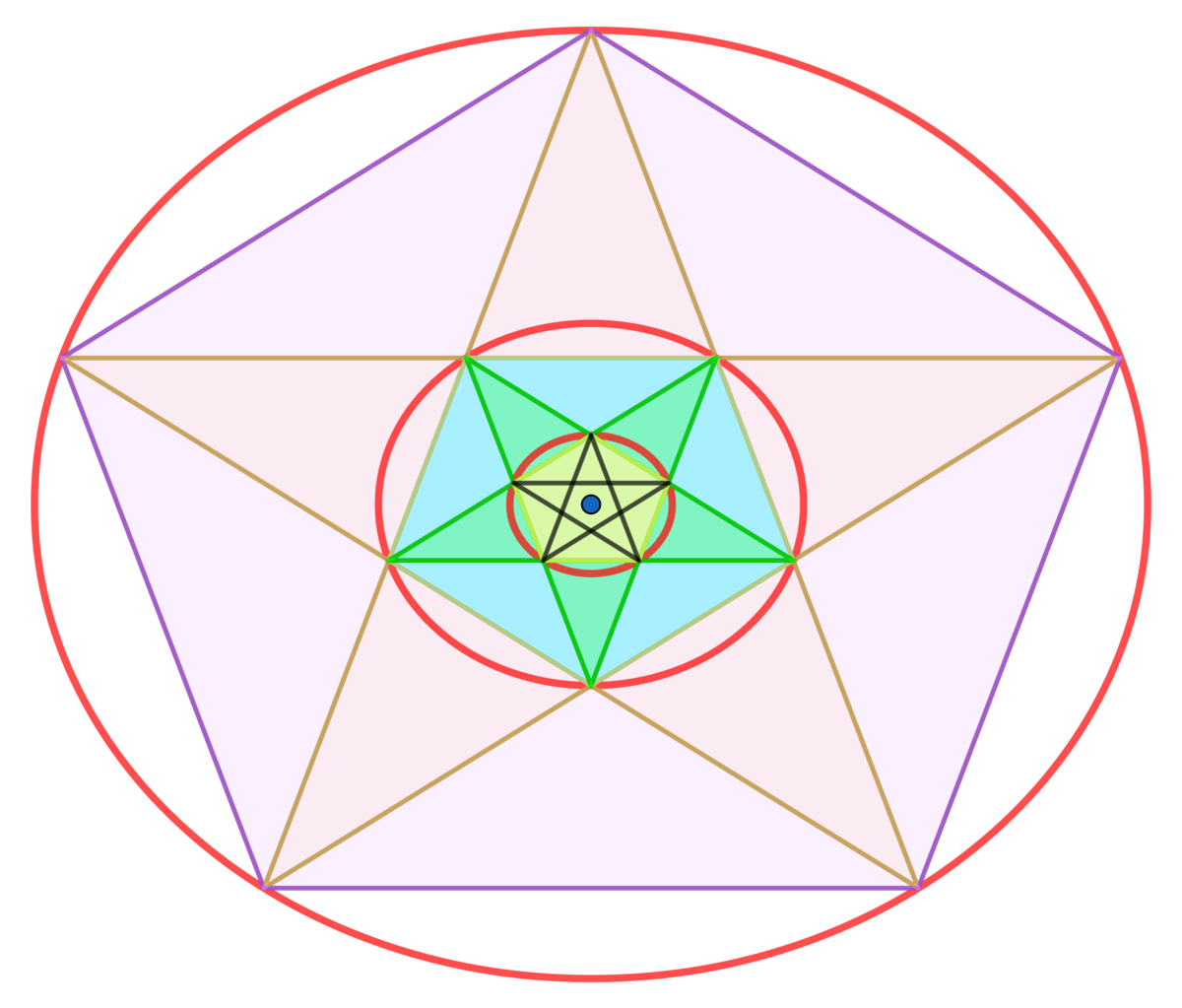It's All Nested

In the above diagram we have nested Pentagons, Pentagrams, and Circles.
For each positive integer n , let r n be the radius of each circle C n and x n be a side of each Pentagon P n .
Let R = ∑ n = 1 ∞ r n and X = ∑ n = 1 ∞ x n .
If r 1 R = x 1 X = c a + b , where a , b and c are coprime positive integers, then find a + b + c .
If r 1 R > x 1 X , then find the sum r 1 R + x 1 X to six decimal places.
If r 1 R < x 1 X , then find the difference x 1 X − r 1 R to six decimal places.
If r 1 R = x 1 X and there does not exist coprime positive integers a , b and c such that r 1 R = x 1 X = c a + b , then enter 0 .
The answer is 8.
This section requires Javascript.
You are seeing this because something didn't load right. We suggest you, (a) try
refreshing the page, (b) enabling javascript if it is disabled on your browser and,
finally, (c)
loading the
non-javascript version of this page
. We're sorry about the hassle.
For Circles:
m ∠ A O P = 5 π and by Inscribed Angle Theorem m ∠ E P F = 2 1 m ∠ E O F ⟹ m ∠ A P O = 1 0 π
O C A C = tan ( 5 π ) ⟹ O C = tan ( 5 π ) A C and P C = tan ( 1 0 π ) A C = r 1 − O C = r − tan ( 5 π ) A C ⟹
h = A C = tan ( 5 π ) + tan ( 1 0 π ) tan ( 1 0 π ) tan ( 5 π ) r 1
tan ( 5 π ) = tan ( 1 0 2 π ) = 1 − tan 2 ( 1 0 π ) 2 tan ( 1 0 π ) ⟹ h = 3 − tan 2 ( 1 0 π ) 2 tan ( 1 0 π ) r 1
Let β = 3 − tan 2 ( 1 0 π ) tan ( 1 0 π ) ⟹ h 1 = 2 β r 1 = r 2 sin ( 5 π ) ⟹ r 2 = sin ( 5 π ) 2 β r 1
In General r n = ( sin ( 5 π ) 2 β ) n − 1 r 1 and R = n = 1 ∑ ∞ r n = sin ( 5 π ) − 2 β sin ( 5 π ) r 1 .
Let u = tan ( 2 x ) ⟹ u 2 = 1 + cos ( x ) 1 − cos ( x ) = ( 1 + cos ( x ) ) 2 sin 2 ( x ) ⟹ u = 1 + cos ( x ) sin ( x ) and u 2 = 1 + cos ( x ) 1 − cos ( x ) ⟹ cos ( x ) = 1 + u 2 1 − u 2 ⟹ sin ( x ) = 1 + u 2 2 u and u = tan ( 2 x )
Let x = 5 π ⟹ u = tan ( 1 0 π ) ⟹ β = 3 − u 2 u and sin ( 5 π ) = 1 + u 2 2 u
⟹ R = 2 ( 1 − u 2 ) 3 − u 2 r 1 and u = tan ( 1 0 π ) = 5 1 2 5 − 1 0 5 ⟹ R = ( 2 1 ) ( 5 5 + 5 ) r 1 = ( 2 1 + 5 ) r 1 ⟹ r 1 R = 2 1 + 5 .
For Hexagons:
Let x 1 be the length of a side of the initial Hexagon.
2 x 1 = r 1 sin ( 5 π ) ⟹ r 1 = 2 x 1 sin ( 5 π )
From above we have h 1 = 2 β r 1 = sin ( 5 π ) β x 1 and x 2 = 2 h 1 = sin ( 5 π ) 2 β x 1 ⟹ x 3 = 2 h 2 = sin ( 5 π ) 2 β x 2 = ( sin ( 5 π ) 2 β ) 2 x 1
In General x n = ( sin ( 5 π ) 2 β ) n − 1 x 1 and from above ⟹ x 1 X = r 1 R = 2 1 + 5 = c a + b ⟹ a + b + c = 8 .